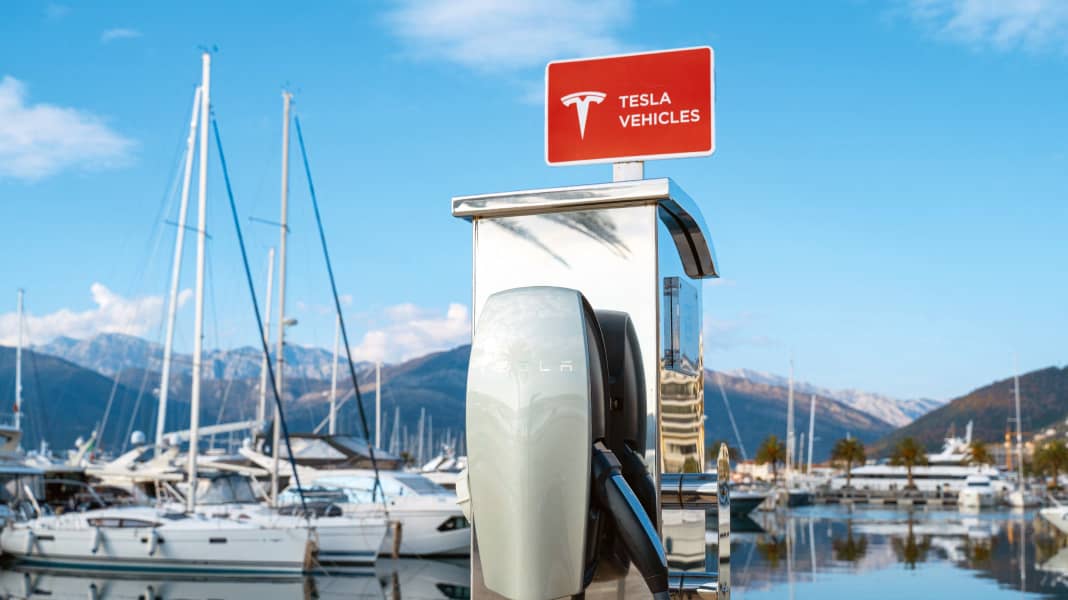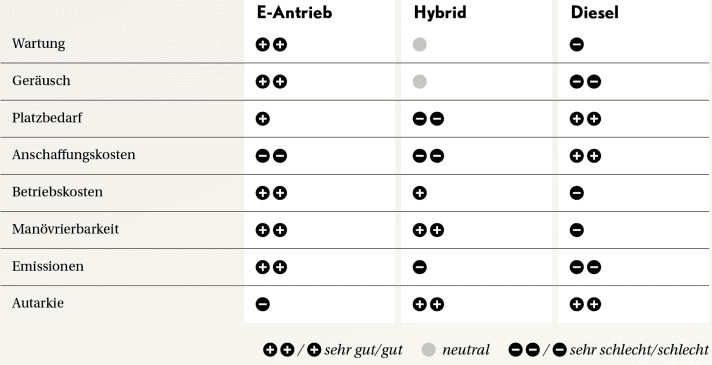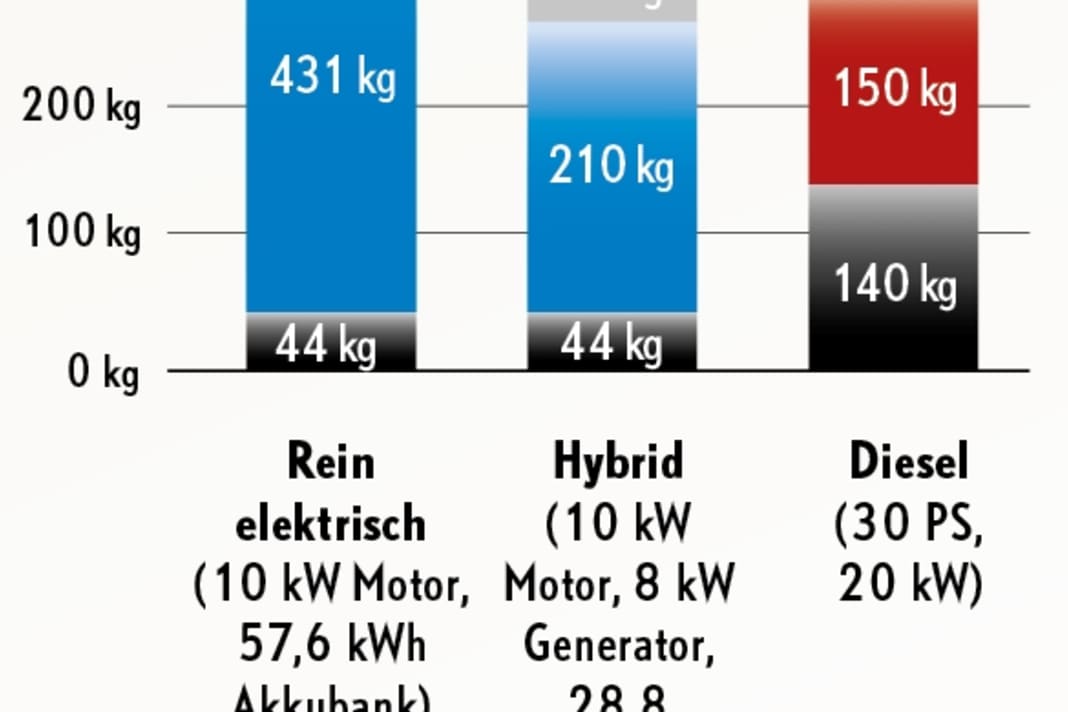Propulsion: Electric, hybrid or diesel? The advantages and disadvantages on yachts
Alexander Worms
· 01.08.2023

As is so often the case, it all depends: The question of the ideal propulsion concept for a sailing yacht is not easy to answer. Logically, because a large, heavy blue water yacht, possibly even a long keel, is not a daysailer on an inland lake. And in the spectrum between these two extremes lies the yacht's own utilisation profile and therefore also the perfect propulsion concept to match.
The drive systems at a glance




On the one hand, there is the classic diesel, which works reliably these days if it is well maintained, but is noisy and emits exhaust fumes. On the other hand, the all-electric drive, super quiet, odourless and emission-free, at least directly on board, which in turn causes problems with the charging infrastructure in the ports.
The hybrid drive lies in the middle between these two poles. It has an electric motor and battery bank as a source of propulsion and also has the option of generating electricity on board from an energy source. In the simplest case, this is a diesel generator, but a fuel cell is also conceivable.
There are currently three systems to choose from - purely electric, hybrid and diesel. Apart from the sails, of course, which - at least according to the name - should be the main propulsion of a sailing yacht. But what makes the concepts different? And what advantages and disadvantages do they have?
The advantages and disadvantages of the drive types
Of course, in addition to the hard facts on the subject of propulsion on board, there are a whole host of opinions, because some people like their electric car and want to motor silently even on the water, while others find the sonorous hum of the diesel soothing.

Some see a negative impact on the environment in the extraction of raw materials for the batteries, others in the burning of fossil fuels. But what do the various drive systems have to offer beyond ideological considerations?
In the sample calculations for the comparison, we have assumed a yacht weighing 4.5 tonnes. The boat should be able to motor for around 50 miles. This is of course a lot for a boat with an electric drive, but it may well be necessary on holiday. A passage of the NOK is also possible. If the personal desired electric range is shorter, prices and weights will of course change in favour of the electric drive.
The electric drive
For the electric motor in our example, this means that it must have an output of 10 kW. "We calculate around 2.5 kW per tonne for ships at sea. This gives you enough reserves when you're up against the wind and waves," explains Marcel Schwarzenberg-Unruh from Fischer Panda. In addition to generators, the Paderborn-based company has also been supplying electric motors to power boats for decades. "We have just equipped a Vindö 40 with a system. The motor draws 5 kW from the batteries at a cruising speed of 5 knots. Interestingly, at three knots, it's only 800 watts," continues the expert. If you factor in a 15 per cent reserve, the battery bank in this case, at 5 knots, must be 57.5 kWh. That's heavy and expensive. As I said, if you can live with less range, you save money and weight.
E-drive: range means weight




In our example, the kilowatt hour of battery capacity still costs around 1,000 euros. That is undoubtedly a lot. "The batteries are certified and tested and therefore safe. Of course, you can also get a kilowatt hour on the open market for 200 euros. The battery management systems are often not included or are of dubious quality. In our experience, insurance companies then find it difficult to cover this," says Schwarzenberg-Unruh. A quick look on the Internet quickly reveals that 300 to 400 euros for 100 ampere hours at 12 volts is quite common. However, it should be noted that not all batteries can supply enough power for a drive, some cannot be connected in parallel or in series or only work within a certain temperature range.
If you don't want to go through all these considerations, you buy a package customised to the motor and ultimately pay for it. For this reason, the batteries recommended by Fischer Panda were used in the example calculation. The system is then six times more expensive than a comparable diesel drive. You have to want that. "We can actually see that many customers either have to have such a system because combustion engines are not permitted on their home turf, or simply want it. They then have an electric car and a particularly energy-efficient house. The boat must not lag behind," says Schwarzenberg-Unruh. Because of the large battery bank required in our example, the entire system also weighs around twice as much as the diesel plus tank. Of course, the well-known advantages of the electric motor, such as freedom from maintenance, quietness and the absence of exhaust fumes on board, should also be mentioned. On top of that: The electric motor makes manoeuvring much easier.
The hybrid drive
A hybrid system combines these advantages of an electric drive with the long range of a diesel. The idea is simple: if you need more range than the battery capacity can provide, an on-board power source helps to generate it. This means that in the vast majority of cases, the vehicle can be driven purely electrically. The power generator only comes into play if you need more range and therefore more power. This could be a fuel cell, although these on-board systems are still under development. The question of storage and the truly climate-neutral production of the hydrogen required is also still open. A dream of the future on yachts. The usual solution is a diesel generator. This also produces exhaust gases, but can run at an optimum speed, and because it does not have to transmit thrust to a drive, but only requires a cable with electricity, it can be very well encapsulated. This makes it quiet and prevents vibrations.
What remains: Exhaust fumes and maintenance. By the way: If the generator is operated with e-fuels, it can be climate-neutral.
If the generator is appropriately dimensioned, it can ensure complete drive self-sufficiency. How often it is used then depends on the size of the battery bank: the larger it is, the less often the diesel will have to help out. However, such a configuration requires a lot of space. This is because a tank is needed in addition to the batteries, and the generator itself must also be accommodated somewhere, in addition to the electric motor. The system is therefore particularly heavy and, depending on the size of the battery, it can also be more expensive than a purely electric drive. On the other hand, it offers a great deal of self-sufficiency and independence from the charging infrastructure on land.
The diesel drive
The diesel engine also offers this. Filling stations are available. It is also inexpensive and relatively light. If the home territory does not impose any restrictions on its usability and ecological considerations are not paramount, then it is still a good alternative. What remains, however: Exhaust fumes, the maintenance required and the noise level under engine.
Spoilt for choice
So what should you do when it comes to buying a new yacht or the end of the life of the diesel engine on board? The individual points need to be assessed individually. Peace and quiet on board versus range anxiety. Costs versus ecological conscience. The installation situation on the ship and weight versus freedom from maintenance and reliability. Before making a decision, it is important to ask yourself exactly what you expect from a drive system and then obtain appropriate quotations. Nobody can take the subsequent decision away from you, it just depends.
Sample calculations for electric, hybrid and diesel
The comparison charts are based on a number of assumptions. If you do not recognise yourself and your way of boating, you can still use the comparison as a guide for your own considerations. We have assumed a displacement of 4.5 tonnes, which is normal for a 30-foot boat. The yacht should be able to travel 50 nautical miles at a cruising speed of 5 knots purely electrically. With this in mind, Fischer Panda has created a fully electric and a hybrid drive concept and specified prices and weights. The prices may of course vary for other providers, but the weight will remain similar. For the weight of the tank, we assumed 120 litres of diesel plus tank and filler neck, as this is a standard size. In addition, the tank is available when converting an existing boat. The range is based on an electrified Vindö 40, which requires around 5 kilowatts of power consumption from the engine at a speed of 5 knots. These values may vary for other yachts. In addition, 15 per cent reserve in the battery and tank have been taken into account. The diesel requires 3 litres per hour at 5 knots. This is also an assumption.





